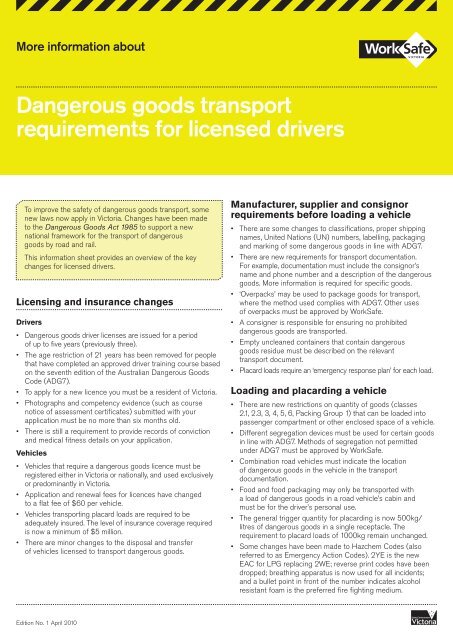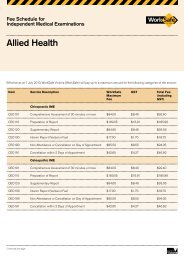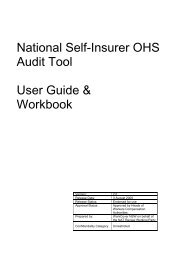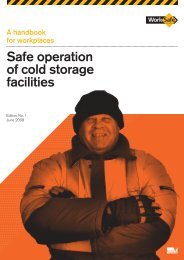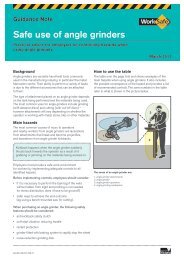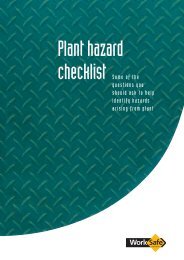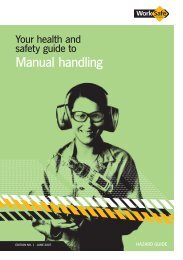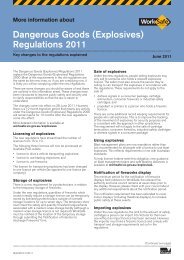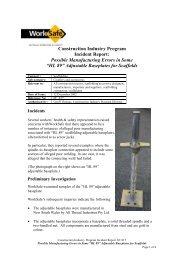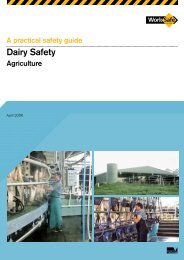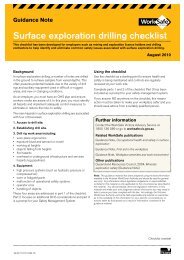Dangerous goods transport requirements for ... - WorkSafe Victoria
Dangerous goods transport requirements for ... - WorkSafe Victoria
Dangerous goods transport requirements for ... - WorkSafe Victoria
- No tags were found...
You also want an ePaper? Increase the reach of your titles
YUMPU automatically turns print PDFs into web optimized ePapers that Google loves.
More in<strong>for</strong>mation about<strong>Dangerous</strong> <strong>goods</strong> <strong>transport</strong><strong>requirements</strong> <strong>for</strong> licensed driversTo improve the safety of dangerous <strong>goods</strong> <strong>transport</strong>, somenew laws now apply in <strong>Victoria</strong>. Changes have been madeto the <strong>Dangerous</strong> Goods Act 1985 to support a newnational framework <strong>for</strong> the <strong>transport</strong> of dangerous<strong>goods</strong> by road and rail.This in<strong>for</strong>mation sheet provides an overview of the keychanges <strong>for</strong> licensed drivers.Licensing and insurance changesDrivers• <strong>Dangerous</strong> <strong>goods</strong> driver licenses are issued <strong>for</strong> a periodof up to five years (previously three).• The age restriction of 21 years has been removed <strong>for</strong> peoplethat have completed an approved driver training course basedon the seventh edition of the Australian <strong>Dangerous</strong> GoodsCode (ADG7).• To apply <strong>for</strong> a new licence you must be a resident of <strong>Victoria</strong>.• Photographs and competency evidence (such as coursenotice of assessment certificates) submitted with yourapplication must be no more than six months old.• There is still a requirement to provide records of convictionand medical fitness details on your application.Vehicles• Vehicles that require a dangerous <strong>goods</strong> licence must beregistered either in <strong>Victoria</strong> or nationally, and used exclusivelyor predominantly in <strong>Victoria</strong>.• Application and renewal fees <strong>for</strong> licences have changedto a flat fee of $60 per vehicle.• Vehicles <strong>transport</strong>ing placard loads are required to beadequately insured. The level of insurance coverage requiredis now a minimum of $5 million.• There are minor changes to the disposal and transferof vehicles licensed to <strong>transport</strong> dangerous <strong>goods</strong>.Manufacturer, supplier and consignor<strong>requirements</strong> be<strong>for</strong>e loading a vehicle• There are some changes to classifications, proper shippingnames, United Nations (UN) numbers, labelling, packagingand marking of some dangerous <strong>goods</strong> in line with ADG7.• There are new <strong>requirements</strong> <strong>for</strong> <strong>transport</strong> documentation.For example, documentation must include the consignor’sname and phone number and a description of the dangerous<strong>goods</strong>. More in<strong>for</strong>mation is required <strong>for</strong> specific <strong>goods</strong>.• ‘Overpacks’ may be used to package <strong>goods</strong> <strong>for</strong> <strong>transport</strong>,where the method used complies with ADG7. Other usesof overpacks must be approved by <strong>WorkSafe</strong>.• A consigner is responsible <strong>for</strong> ensuring no prohibiteddangerous <strong>goods</strong> are <strong>transport</strong>ed.• Empty uncleaned containers that contain dangerous<strong>goods</strong> residue must be described on the relevant<strong>transport</strong> document.• Placard loads require an ‘emergency response plan’ <strong>for</strong> each load.Loading and placarding a vehicle• There are new restrictions on quantity of <strong>goods</strong> (classes2.1, 2.3, 3, 4, 5, 6, Packing Group 1) that can be loaded intopassenger compartment or other enclosed space of a vehicle.• Different segregation devices must be used <strong>for</strong> certain <strong>goods</strong>in line with ADG7. Methods of segregation not permittedunder ADG7 must be approved by <strong>WorkSafe</strong>.• Combination road vehicles must indicate the locationof dangerous <strong>goods</strong> in the vehicle in the <strong>transport</strong>documentation.• Food and food packaging may only be <strong>transport</strong>ed witha load of dangerous <strong>goods</strong> in a road vehicle’s cabin andmust be <strong>for</strong> the driver’s personal use.• The general trigger quantity <strong>for</strong> placarding is now 500kg/litres of dangerous <strong>goods</strong> in a single receptacle. Therequirement to placard loads of 1000kg remain unchanged.• Some changes have been made to Hazchem Codes (alsoreferred to as Emergency Action Codes). 2YE is the newEAC <strong>for</strong> LPG replacing 2WE; reverse print codes have beendropped; breathing apparatus is now used <strong>for</strong> all incidents;and a bullet point in front of the number indicates alcoholresistant foam is the preferred fire fighting medium.Edition No. 1 April 2010
<strong>Dangerous</strong> <strong>goods</strong> <strong>transport</strong><strong>requirements</strong> <strong>for</strong> licensed driversUnloading a vehicle• The consignor, prime contractor or driver must amenddocumentation to show correct number of full and emptycontainers and quantities of dangerous <strong>goods</strong> on a vehicleat all times.• A person must not use hose assemblies <strong>for</strong> bulk transferof dangerous <strong>goods</strong> if not constructed, assembled ormaintained in accordance with ADG7.• A driver must not unload, detach a trailer or operate a roadtanker vehicle equipped with a burner, except in accordancewith relevant parts of ADG7.Safety equipment and emergencies• A person must not drive a road vehicle if the vehicle orequipment isn’t in good working order and not inspectedand tested in line with ADG7.• Food and food packaging must not be moved from anincident site unless permission is given by <strong>WorkSafe</strong> <strong>Victoria</strong>.Further in<strong>for</strong>mationWe encourage you to seek further in<strong>for</strong>mation to fullyunderstand your responsibilities. Visit worksafe.vic.gov.au<strong>for</strong> more detailed in<strong>for</strong>mation about dangerous <strong>goods</strong> <strong>transport</strong><strong>requirements</strong>, or phone <strong>WorkSafe</strong>’s Advisory Service on1800 136 089 if you have any questions.Worksafe Advisory ServiceToll-free: 1800 136 089Email: info@worksafe.vic.gov.auworksafe.vic.gov.auThe in<strong>for</strong>mation presented in this document is intended<strong>for</strong> general use only. It should not be viewed as a definitiveguide to the law and should be read in conjunction with theamended <strong>Dangerous</strong> Goods Act 1985 and the <strong>Dangerous</strong>Goods (Transport by Road or Rail) Regulations 2008.Other• A number of definitions have changed. For example,‘dangerous <strong>goods</strong> in bulk’ has been replaced with simplifiedtrigger quantities – 500kg/litres. Terms such as ‘bulkdangerous <strong>goods</strong>’ and ‘<strong>transport</strong> in bulk’ are no longer usedin ADG7, except with respect to solid dangerous <strong>goods</strong>.• Some new definitions have been added, including ‘overpack’,‘multiple element gas container’ and ‘retail distribution load’.• A person must not consign, load or drive a vehicle <strong>transport</strong>ingdangerous <strong>goods</strong> if the person knows, or should know, thatthe vehicle, equipment, labelling, packaging or <strong>transport</strong> doesnot comply with ADG7.• There are changes to <strong>transport</strong> smaller quantities ofdangerous <strong>goods</strong>, with five new categories being created.• There are now increased penalties and sanctions <strong>for</strong> thosefound guilty of offences, especially serious offences involvingthe death or serious injury of a person.VWA1321/01/02.102


